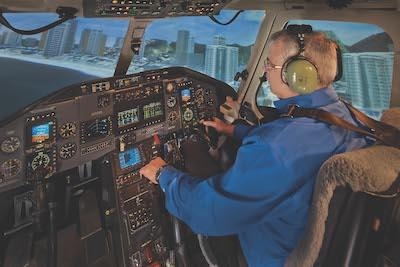Tue, Mar 05, 2019
To Add Advanced Energy Management - Rotorcraft Course
FlightSafety International will add a new Advanced Energy Management – Rotorcraft course to its Master Aviator program for helicopter pilots in the coming months.

"We are pleased to enhance the FlightSafety Master Aviator program for helicopter pilots with this new Advanced Energy Management course," said Steve Gross, Senior vice president, Commercial. "Master Aviator sets a new standard for pilot achievement and recognition, enabling pilots to develop a deeper knowledge of the helicopter they fly, as well as a safe and correct response to a broad range of demanding, unexpected situations."
FlightSafety Master Aviator for helicopter pilots is earned by completing all advanced aircraft- specific core courses and a choice of four electives. At least one FlightSafety initial or recurrent training event must also be completed every 8 months.
The one-day core courses now include Advanced Energy Management - Rotorcraft, Advanced Helicopter Crew Resource Management, and Advanced Helicopter Surviving Inadvertent Instrument Meteorological Conditions.
The Advanced Energy Management course increases a pilot’s understanding of helicopter aerodynamics and introduces techniques to improve control of the helicopter and rotor energy during normal and abnormal operations. Pilots will focus on Crew Resource Management, Energy Situational Awareness and managing the kinetic and potential energy available to them while flying.
The Advanced Crew Resource Management course enables the pilots to master the key aspects of CRM that uniquely apply to helicopter operation. This includes situational awareness, conflict resolution and communication skills. They will also experience how effective crew performance and decision-making can overcome situations caused by error chains, human factors and fatigued or stressed operators.
The inadvertent IMC course will help pilots to be fully prepared when weather conditions unexpectedly and rapidly change in order to have sound and well-practiced strategy to maintain the safety of their aircraft. This course provides the tools needed to react appropriately as decisions made in the first pivotal moments often decide the outcome. Pilots will also review and fully understand the major causes for inadvertent IMC accidents and master best practices for the safest responses.
(Image provided with FlightSafety news release)
More News
Secondary Radar/Radar Beacon (ATCRBS) A radar system in which the object to be detected is fitted with cooperative equipment in the form of a radio receiver/transmitter (transponde>[...]
Aero Linx: Australian Society of Air Safety Investigators (ASASI) The Australian Society of Air Safety Investigators (ASASI) was formed in 1978 after an inaugural meeting held in M>[...]
Make Sure You NEVER Miss A New Story From Aero-News Network Do you ever feel like you never see posts from a certain person or page on Facebook or Instagram? Here’s how you c>[...]
From 2023 (YouTube Edition): Barking up the Right Tree Australian-born, the Aeropup is a remarkably robust, fully-customizable, go-anywhere, two-seat, STOL/LSA aircraft. The machin>[...]
Also: New Amelia Search, B737 Flap Falls Off, SUN ‘n FUN Unveiling, F-16 Record Captain Sully Sullenberger, the pilot who saved 155 people by safely landing an A320 in the Hu>[...]
 ANN's Daily Aero-Term (07.12.25): Secondary Radar/Radar Beacon (ATCRBS)
ANN's Daily Aero-Term (07.12.25): Secondary Radar/Radar Beacon (ATCRBS) ANN's Daily Aero-Linx (07.12.25)
ANN's Daily Aero-Linx (07.12.25) ANN FAQ: Turn On Post Notifications
ANN FAQ: Turn On Post Notifications Classic Aero-TV: Of the Aeropup and its Pedigree
Classic Aero-TV: Of the Aeropup and its Pedigree Airborne 07.07.25: Sully v Bedford, RAF Vandalism, Discovery Moving?
Airborne 07.07.25: Sully v Bedford, RAF Vandalism, Discovery Moving?



